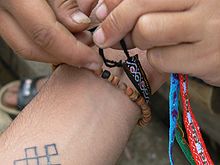How to be an ally

Recently I wrote a blog at Feminspire about how a lot of people peg homeschoolers as religious families only, when really only about 30 percent say they primarily homeschool for religious reasons. An ad for a homeschooling supplier of curriculum, however, made me ill when I read its banner. It read all kinds of things that homeschooled children apparently do—though I dispel this myth in my blog, above—which includes this statement: “Homeschooled children don’t learn that Timmy has two daddies.”
Many homeschoolers certainly do. In fact, some have two daddies themselves. My Feminspire post helped me release some of the anger these blanket statements made me feel, but I also wanted to create a post about how we can stop this ignorance, intolerance and hate early on in our families. One of the ways is to definitely be and raise allies, which led me to this post.
One of the best ways we can foster GLBT understanding and safety among our students is to work towards being allies. The ally tools sponsored by the Gay, Lesbian, and Straight Education Network serve as a helpful focal point. They help people commit to:
- Refraining from using anti-LGBT slurs or language
- Stepping in or telling an adult when witnessing student harassment
- Working to end harassment and bullying
- Recruiting more allies
Click here to sign an ally pledge and share it with friends. Once you pledge to be an ally, here are many other things you can do to support LGBT youth.
- Create a Gay Straight Alliance Club with friends. You might want to consider creating one for the entire community as well, in order to garner even greater support and help educate more people.
- Implement LGBT lessons into your homeschooling. Teaching Tolerance has dozens of plans to get you started, from a lesson about gay rights editorial cartoons to an activity to help discuss LGBT bullying. Search for more specific activity ideas and lesson plans here. GLSEN provides many lesson plans and activity ideas as well.
- Create a poster for people to sign, including ways to be an ally together. Alternatively, brainstorm ideas together, then print it up and have everyone sign it as a commitment to being an ally. Consider creating a Commitment to Respect poster together.
- Pass out Ally Pledge cards or host a sign-up table or assembly surrounding the topic. Download Pledge Cards to print out and make them available in the community.
- Commit to creating safe zones. See if you can acquire a kit for making safe spaces, or simply download one.
- Use the Teaching Tolerance Bullying Kit to help create a safe environment.
- Read and share stories of other allies. Find out what being an ally means to different people and create your own goals for your role.
- Provide an Ally training, workshop, or meeting. Use the Ally 101 Workshop Guide to get started.
- Take action by downloading ally nametags, creating a video, writing a short essay about why you decided to be an ally, and more. Consider using some of these ideas as the basis for an activity, or even sharing them at church, your social and volunteer organizations, and with family. These are good topics to use at leadership events, such as Student Council retreats or National Honor Society conferences, as well.
- Order various items to use in your home or classroom, such as posters, stickers, wristbands, and even t-shirts. For an even more personalized touch, create your own as a group or class.
Photo courtesy of Wikipedia

0 comments